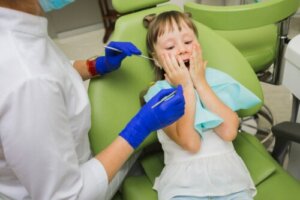Do Genetics Influence Your Child's Cavities?


Written and verified by the dentist Vanesa Evangelina Buffa
It’s common knowledge that eating sweets and not cleaning your teeth properly are risk factors for tooth damage. But have you ever wondered how much genetics influences the development of your child’s cavities? In this article, we’ll tell you what science has to say about it.
Childhood cavities are one of the most common childhood diseases. According to the World Health Organization in 2017, more than 530 million children worldwide had cavities in their baby teeth.
Behaviors and habits are the most important factors when it comes to the appearance of the disease. However, there’s also a genetic component that needs attention. Many parents who’ve suffered from cavities from an early age wonder if they’ll pass this disease on to their children. Let’s take a closer look at the role of genetics in the development of this disease.
How do cavities form in children?
Dental cavities are considered a chronic, multifactorial disease. They’re the deterioration of teeth due to demineralization that occurs when the oral environment becomes very acidic. This acid comes from bacteria in the mouth that process carbohydrates in our diet.
When oral hygiene is absent or poor, or the diet includes a high content of simple sugars, there’s a greater proliferation of germs. This increases the production of acids and, as a result, the teeth lose more minerals and cavities progress.
According to studies carried out by the Scientific Journal of Dentistry, the disease is the result of an ecological imbalance of the biofilm, which is a group of microorganisms that adhere to living tissue, and their reproduction is caused by excessive sugar intake.
However, other situations also play a role, such as the persistence of this imbalance over time and the characteristics of the host. Regarding the latter, some characteristics depend on factors that are inherited:
- The amount of saliva
- The pH of the mouth
- The anatomy of the teeth

The relationship between your child’s cavities and genetics
As we mentioned above, childhood cavities occur due to an imbalance in the oral environment. This is related to a high intake of sugars and poor oral hygiene. However, although it’s not a determining factor, genetics can influence the greater predisposition to suffer from this disease.
The role of genetic factors in the appearance and development of dental cavities is a subject that’s still being investigated. According to a review of the literature from the Central University of Ecuador, genetics could contribute to the development of cavities through 4 main groups of genes:
- Those that act on the morphological development of dental enamel, due to the fact that lower quality enamel favors the colonization of microorganisms and destruction. Likewise, the roughness of the tooth surfaces or the number and shape of the cusps increase the retention of bacterial plaque and predispose individuals to the development of cavities.
- Those involved in the preference of certain flavors, as they contribute to the excessive consumption of carbohydrates and sugars, which favors the development of the disease.
- Genes that influence the secretion or quality of saliva, affecting its protective function.
- Genomic sequences that affect the immune response and favor the proliferation of pathogenic germs.

The transmission of these genes between generations explains the tendency of several members of a family to suffer from cavities. In any case, it’s the increased predisposition that’s inherited, and not the disease itself. As we’ve already mentioned, other factors are necessary for the demineralization of teeth to occur.
According to the Universitas Odontológica Magazine, these genes are well-identified. But unless specific genetic studies are carried out, it’s not possible to know if your child is a carrier of the sequences that predispose them to have more cavities. For this reason, it’s important to monitor the environmental factors on which it’s possible to take action.
If I have cavities, will my child have them too?
To answer this question, it’s not only necessary to evaluate whether genetics influences cavities in children. It’s also important to analyze the oral health status of the parents, family habits, diet, and hygiene habits.
It’s true that children can inherit certain oral characteristics that predispose them to cavities. But there are several factors necessary for them to develop the disease.
If parents have their mouths in poor condition (with cavities, tartar, or active and untreated periodontal disease) they can transmit the pathogenic bacteria from their mouths to their children. In this case, your little ones may develop lesions in their teeth early because of their parents, but not by inheritance.
Tasting your children’s food, blowing on their food, cleaning pacifiers with your own saliva, or giving them kisses in the mouth are actions that contribute to the transmission of germs.
In addition, if foods rich in sugar are consumed in the family, the risk increases. Giving little ones sugary drinks or very sweet foods favors the multiplication of bacteria and the production of acids that damage the teeth.
Likewise, the lack of attention to oral hygiene habits is another situation that can put the teeth of the little ones at risk. Parents may have cavities because they don’t brush their teeth with the indicated technique or frequency. If you repeat this harmful behavior with your child, the chances are that your child’s teeth will also suffer the consequences of poor hygiene.
Clarifying studies
External factors such as behaviors, teachings, and habits influence children’s oral health. This is explained by a study published in the Australian journal Pediatrics.
Two hundred and fifty twin pregnancies (identical and fraternal) were recruited for the study. Demographic, health, and phenotypic data were collected at gestation, birth, 18 months, and 6 years of age. When analyzing the development of cavities in the children, the study showed that one in three of the twins studied (32.2%) had the disease and 24% had lesions in advanced stages.
In their observations, the researchers noted that when comparing the oral health of identical twins, it was no more similar than that of fraternal twins. They concluded that the risk of cavities is related to environmental rather than genetic factors. The study found a close relationship between children’s oral health and the mother’s lifestyle, behaviors, and health during pregnancy.
Genetics and the environment in the development of your child’s cavities
On the other hand, a study published in the National Library of Medicine evaluated the genetic and environmental factors that contribute to the development of early childhood cavities.
After evaluating 259 unrelated children, they determined that there are external situations and genetic interactions that can act as protective factors or risk factors for early childhood cavities.
Genetics, then, can predispose children to the development of cavities or prevent their development. Hereditary and environmental factors together contribute to whether or not the disease develops.
Preventing your child’s cavities goes beyond genetics
Just because you’ve suffered from tooth problems throughout your life doesn’t mean that your offspring should repeat your story. Beyond genetics, it’s the care you take with your child’s oral health that will help prevent cavities.
Providing your children with a healthy, low-sugar diet is essential in order to prevent tooth damage. In addition, you should take care to properly sanitize your children’s mouths from an early age. And don’t forget that regular visits to a pediatric dentist complete the care.
It’s common knowledge that eating sweets and not cleaning your teeth properly are risk factors for tooth damage. But have you ever wondered how much genetics influences the development of your child’s cavities? In this article, we’ll tell you what science has to say about it.
Childhood cavities are one of the most common childhood diseases. According to the World Health Organization in 2017, more than 530 million children worldwide had cavities in their baby teeth.
Behaviors and habits are the most important factors when it comes to the appearance of the disease. However, there’s also a genetic component that needs attention. Many parents who’ve suffered from cavities from an early age wonder if they’ll pass this disease on to their children. Let’s take a closer look at the role of genetics in the development of this disease.
How do cavities form in children?
Dental cavities are considered a chronic, multifactorial disease. They’re the deterioration of teeth due to demineralization that occurs when the oral environment becomes very acidic. This acid comes from bacteria in the mouth that process carbohydrates in our diet.
When oral hygiene is absent or poor, or the diet includes a high content of simple sugars, there’s a greater proliferation of germs. This increases the production of acids and, as a result, the teeth lose more minerals and cavities progress.
According to studies carried out by the Scientific Journal of Dentistry, the disease is the result of an ecological imbalance of the biofilm, which is a group of microorganisms that adhere to living tissue, and their reproduction is caused by excessive sugar intake.
However, other situations also play a role, such as the persistence of this imbalance over time and the characteristics of the host. Regarding the latter, some characteristics depend on factors that are inherited:
- The amount of saliva
- The pH of the mouth
- The anatomy of the teeth

The relationship between your child’s cavities and genetics
As we mentioned above, childhood cavities occur due to an imbalance in the oral environment. This is related to a high intake of sugars and poor oral hygiene. However, although it’s not a determining factor, genetics can influence the greater predisposition to suffer from this disease.
The role of genetic factors in the appearance and development of dental cavities is a subject that’s still being investigated. According to a review of the literature from the Central University of Ecuador, genetics could contribute to the development of cavities through 4 main groups of genes:
- Those that act on the morphological development of dental enamel, due to the fact that lower quality enamel favors the colonization of microorganisms and destruction. Likewise, the roughness of the tooth surfaces or the number and shape of the cusps increase the retention of bacterial plaque and predispose individuals to the development of cavities.
- Those involved in the preference of certain flavors, as they contribute to the excessive consumption of carbohydrates and sugars, which favors the development of the disease.
- Genes that influence the secretion or quality of saliva, affecting its protective function.
- Genomic sequences that affect the immune response and favor the proliferation of pathogenic germs.

The transmission of these genes between generations explains the tendency of several members of a family to suffer from cavities. In any case, it’s the increased predisposition that’s inherited, and not the disease itself. As we’ve already mentioned, other factors are necessary for the demineralization of teeth to occur.
According to the Universitas Odontológica Magazine, these genes are well-identified. But unless specific genetic studies are carried out, it’s not possible to know if your child is a carrier of the sequences that predispose them to have more cavities. For this reason, it’s important to monitor the environmental factors on which it’s possible to take action.
If I have cavities, will my child have them too?
To answer this question, it’s not only necessary to evaluate whether genetics influences cavities in children. It’s also important to analyze the oral health status of the parents, family habits, diet, and hygiene habits.
It’s true that children can inherit certain oral characteristics that predispose them to cavities. But there are several factors necessary for them to develop the disease.
If parents have their mouths in poor condition (with cavities, tartar, or active and untreated periodontal disease) they can transmit the pathogenic bacteria from their mouths to their children. In this case, your little ones may develop lesions in their teeth early because of their parents, but not by inheritance.
Tasting your children’s food, blowing on their food, cleaning pacifiers with your own saliva, or giving them kisses in the mouth are actions that contribute to the transmission of germs.
In addition, if foods rich in sugar are consumed in the family, the risk increases. Giving little ones sugary drinks or very sweet foods favors the multiplication of bacteria and the production of acids that damage the teeth.
Likewise, the lack of attention to oral hygiene habits is another situation that can put the teeth of the little ones at risk. Parents may have cavities because they don’t brush their teeth with the indicated technique or frequency. If you repeat this harmful behavior with your child, the chances are that your child’s teeth will also suffer the consequences of poor hygiene.
Clarifying studies
External factors such as behaviors, teachings, and habits influence children’s oral health. This is explained by a study published in the Australian journal Pediatrics.
Two hundred and fifty twin pregnancies (identical and fraternal) were recruited for the study. Demographic, health, and phenotypic data were collected at gestation, birth, 18 months, and 6 years of age. When analyzing the development of cavities in the children, the study showed that one in three of the twins studied (32.2%) had the disease and 24% had lesions in advanced stages.
In their observations, the researchers noted that when comparing the oral health of identical twins, it was no more similar than that of fraternal twins. They concluded that the risk of cavities is related to environmental rather than genetic factors. The study found a close relationship between children’s oral health and the mother’s lifestyle, behaviors, and health during pregnancy.
Genetics and the environment in the development of your child’s cavities
On the other hand, a study published in the National Library of Medicine evaluated the genetic and environmental factors that contribute to the development of early childhood cavities.
After evaluating 259 unrelated children, they determined that there are external situations and genetic interactions that can act as protective factors or risk factors for early childhood cavities.
Genetics, then, can predispose children to the development of cavities or prevent their development. Hereditary and environmental factors together contribute to whether or not the disease develops.
Preventing your child’s cavities goes beyond genetics
Just because you’ve suffered from tooth problems throughout your life doesn’t mean that your offspring should repeat your story. Beyond genetics, it’s the care you take with your child’s oral health that will help prevent cavities.
Providing your children with a healthy, low-sugar diet is essential in order to prevent tooth damage. In addition, you should take care to properly sanitize your children’s mouths from an early age. And don’t forget that regular visits to a pediatric dentist complete the care.
All cited sources were thoroughly reviewed by our team to ensure their quality, reliability, currency, and validity. The bibliography of this article was considered reliable and of academic or scientific accuracy.
- Abbasoğlu, Z., Tanboğa, İ., Calvano Küchler, E., Deeley, K., Weber, M., Kaspar, C., … & Vieira, A. R. (2015). Early childhood caries is associated with genetic variants in enamel formation and immune response genes. Caries research, 49(1), 70-77. https://www.ncbi.nlm.nih.gov/pmc/articles/PMC4376372/
- Calle-Sánchez, M. J., Baldeón-Gutiérrez, R. E., Curto-Manrique, J., Céspedes-Martínez, D. I., Góngora-León, I. A., Molina-Arredondo, K. E., & de Priego, G. A. P. M. (2018). Teorías de caries dental y su evolución a través del tiempo: Revisión de literatura. Revista Científica Odontológica, 6(1), 98-105. https://revistas.cientifica.edu.pe/index.php/odontologica/article/view/426
- Organización Mundial de la Salud. (2021). Poner fin a la caries dental en la infancia: manual de aplicación de la OMS. Organización Mundial de la Salud. Licencia: CC BY-NC-SA 3.0 IGO. https://apps.who.int/iris/handle/10665/340445.
- Mateo, K. F. O., Lerma, M. G. F., Angulo, M. G., & Schmidt, R. P. M. (2021). Genes associated with the carious process. Revista Mexicana de Periodontología, 12(1-3), 18-29. https://www.medigraphic.com/cgi-bin/new/resumenI.cgi?IDARTICULO=102955&idP=9652
- Muhamad, A. H., & Watted, N. (2019). Genetics in pediatric dentistry: A review. International Journal of Applied Dental Sciences 2019; 5 (3): 401, 408. https://www.oraljournal.com/pdf/2019/vol5issue3/PartF/5-3-60-557.pdf
- Prieto, S. J. G., García, D. A., Santacoloma, S., & Mejía, J. P. (2013). Caries dental:¿ influyen la genética y la epigenética en su etiología? Revisión de la literatura. Universitas Odontologica, 32(69), 83-92. https://revistas.javeriana.edu.co/index.php/revUnivOdontologica/article/view/SICI:%202027-3444(201307)32:69%3C83:CDIGEE%3E2.0.CO;2-A
- Silva, M. J., Kilpatrick, N. M., Craig, J. M., Manton, D. J., Leong, P., Burgner, D. P., & Scurrah, K. J. (2019). Genetic and early-life environmental influences on dental caries risk: a twin study. Pediatrics, 143(5). https://publications.aap.org/pediatrics/article/143/5/e20183499/37119/Genetic-and-Early-Life-Environmental-Influences-on
- Viteri Moya, J., Morales, Á., Salazar, C., Vaca, R., Fernández, J., Valenzuela, V., & Viteri, J. (2021). Genética de la caries. https://zenodo.org/record/5451093#.ZF6fw3bMK3A
This text is provided for informational purposes only and does not replace consultation with a professional. If in doubt, consult your specialist.








